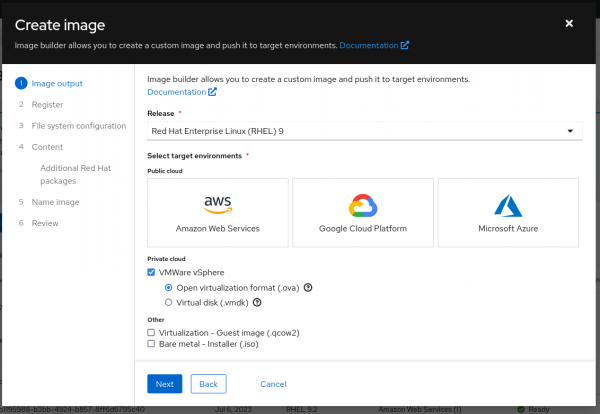The Red Hat Enterprise Linux image builder is now available for VMware vSphere with your Red Hat Enterprise Linux (RHEL) subscription. This service offers a simplified and efficient approach to creating personalized RHEL operating system images, complete with the latest updates and security enhancements for your hybrid cloud environments. It can be found on the left navigation of the Red Hat Hybrid Cloud Console.
VMware vSphere on RHEL image builder
The bundled Red Hat Lightspeed (formerly Red Hat Insights) image builder, integrated with Red Hat Lightspeed, enables users to craft personalized images and seamlessly deploy them to their chosen cloud platforms like Amazon Web Services, Microsoft Azure, and Google Cloud Platform. It facilitates the download and upload of tailored images to the vSphere client and the creation of customized bare metal and guest images.
The RHEL image builder essentially offers downloadable images for VMware vSphere, an installer image tailored for physical servers, customizable filesystem mount points, and convenient auto-registration features for accessing the latest RHEL bug and security fixes (Figure 1). Additionally, users can benefit from an automated lookup of activation keys linked to their account, and the service now supports image creation for both RHEL 8 and RHEL 9.

Open VMDK
Open VMDK is a vital tool for creating Open Virtual Appliances (OVAs), the tar archive files following the Open Virtualization Format (OVF) standard. These OVAs comprise an OVF descriptor (.ovf), one or more virtual machine disk image files (.vmdk), and a manifest file (.mf).
The tool has two main parts:
vmdk-convert: This converts raw, flat, or sparse vmdk images into stream optimized disk image format, essential for efficient streaming over networks.ova-compose: This generates the OVF file from a simple yaml config file.ova-compose, then assembles the final OVA using the OVF file, VMDK images, and a manifest file containing checksums.
The VMDK format specification can be downloaded at https://www.vmware.com/app/vmdk/?src=vmdk (pdf).
The OVF/OVA specification can be found at https://www.dmtf.org/standards/ovf.
There is a list of hardware features available with virtual machine compatibility settings for reference.
What’s new in RHEL image builder?
As of July 2023, the RHEL image builder is able to produce a proper OVF file along with VMDK and combine in an OVA file, and is available here. This feature allows for the creation of OVA files directly through the RHEL image builder. The OVF included in these images is intentionally minimal, with the expectation that users will customize the VM before booting. VMware has confirmed successful tests of the generated OVA images, covering RHEL 8 and RHEL 9 releases. There is no default user/password. Instead, users can generate one by attaching a cloud-init ISO in a CD-ROM drive to the image.
Learn more about creating and uploading a customized RHEL VMDK system image to vSphere here.
Why the new features are important for developers
Due to increasing customer demand, improving the compatibility and versioning of VMDK images has been a strategic focus for both VMware and Red Hat. The open-vmdk tool is a valuable resource for addressing these concerns as it provides enhanced support for VMware in comprehensive build and launch workflows. Red Hat offers both an on-prem tool and a hosted service for the RHEL image builder. This service allows developers to create customized RHEL images tailored to their specific needs.
Upon importing an .ova file, a virtual machine (VM) is created. Within the vSphere environment, users then have the capability to fine-tune the VM configuration by incorporating additional hardware elements, such as network interfaces, storage disks, and CD-ROM drives. This process enables precise customization of the virtualized environment to meet specific operational requirements.
Understanding the compatibility and versioning of VMDK images is crucial, especially for users working with VMware environments. By utilizing tools like open-vmdk, it's possible to enhance the support and compatibility of these images, ensuring a smoother workflow.
For those using Red Hat Enterprise Linux, the availability of the image builder service offers a powerful tool for creating customized images, both on-premises and through a hosted service. This allows for greater flexibility and customization in deploying RHEL-based VMs. For storage, we suggest the pvscsi device, and the vmxnet3 device for networking.
Additional reading
- Creating and uploading a customized RHEL VMDK system image to vSphere
- Deploy and Export OVF and OVA Templates
- Announcing full support for new Red Hat Enterprise Linux image builder service
- Build RHEL images for Azure with Image Builder
- VMware Virtual machine hardware versions
- List of ESXi/ESX hosts and compatible virtual machine hardware versions
- VMware product lifecycle matrix
